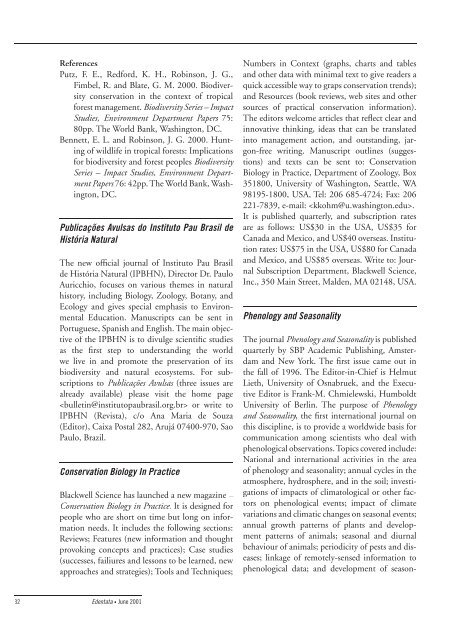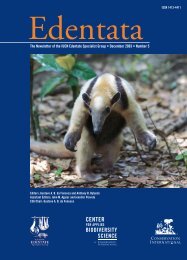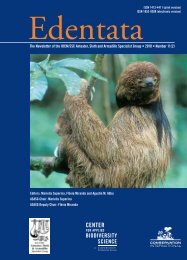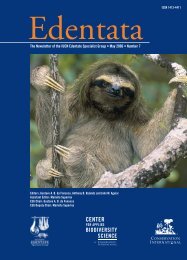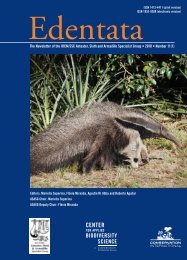Edentata 4 - Anteater, Sloth & Armadillo Specialist Group
Edentata 4 - Anteater, Sloth & Armadillo Specialist Group
Edentata 4 - Anteater, Sloth & Armadillo Specialist Group
Create successful ePaper yourself
Turn your PDF publications into a flip-book with our unique Google optimized e-Paper software.
References<br />
Putz, F. E., Redford, K. H., Robinson, J. G.,<br />
Fimbel, R. and Blate, G. M. 2000. Biodiversity<br />
conservation in the context of tropical<br />
forest management. Biodiversity Series – Impact<br />
Studies, Environment Department Papers<br />
75:<br />
80pp. The World Bank, Washington, DC.<br />
Bennett, E. L. and Robinson, J. G. 2000. Hunting<br />
of wildlife in tropical forests: Implications<br />
for biodiversity and forest peoples Biodiversity<br />
Series – Impact Studies, Environment Department<br />
Papers 76: 42pp. The World Bank, Wash-<br />
ington, DC.<br />
Publicações Avulsas do Instituto Pau Brasil de<br />
História Natural<br />
The new official journal of Instituto Pau Brasil<br />
de História Natural (IPBHN), Director Dr. Paulo<br />
Auricchio, focuses on various themes in natural<br />
history, including Biology, Zoology, Botany, and<br />
Ecology and gives special emphasis to Environmental<br />
Education. Manuscripts can be sent in<br />
Portuguese, Spanish and English. The main objective<br />
of the IPBHN is to divulge scientific studies<br />
as the first step to understanding the world<br />
we live in and promote the preservation of its<br />
biodiversity and natural ecosystems. For subscriptions<br />
to Publicações Avulsas (three issues are<br />
already available) please visit the home page<br />
or write to<br />
IPBHN (Revista), c/o Ana Maria de Souza<br />
(Editor), Caixa Postal 282, Arujá 07400-970, Sao<br />
Paulo, Brazil.<br />
Conservation Biology In Practice<br />
Blackwell Science has launched a new magazine –<br />
Conservation Biology in Practice. It is designed for<br />
people who are short on time but long on information<br />
needs. It includes the following sections:<br />
Reviews; Features (new information and thought<br />
provoking concepts and practices); Case studies<br />
(successes, failiures and lessons to be learned, new<br />
approaches and strategies); Tools and Techniques;<br />
Numbers in Context (graphs, charts and tables<br />
and other data with minimal text to give readers a<br />
quick accessible way to graps conservation trends);<br />
and Resources (book reviews, web sites and other<br />
sources of practical conservation information).<br />
The editors welcome articles that reflect clear and<br />
innovative thinking, ideas that can be translated<br />
into management action, and outstanding, jargon-free<br />
writing. Manuscript outlines (suggestions)<br />
and texts can be sent to: Conservation<br />
Biology in Practice, Department of Zoology, Box<br />
351800, University of Washington, Seattle, WA<br />
98195-1800, USA, Tel: 206 685-4724; Fax: 206<br />
221-7839, e-mail: .<br />
It is published quarterly, and subscription rates<br />
are as follows: US$30 in the USA, US$35 for<br />
Canada and Mexico, and US$40 overseas. Institution<br />
rates: US$75 in the USA, US$80 for Canada<br />
and Mexico, and US$85 overseas. Write to: Journal<br />
Subscription Department, Blackwell Science,<br />
Inc., 350 Main Street, Malden, MA 02148, USA.<br />
Phenology and Seasonality<br />
The journal Phenology and Seasonality<br />
is published<br />
quarterly by SBP Academic Publishing, Amsterdam<br />
and New York. The first issue came out in<br />
the fall of 1996. The Editor-in-Chief is Helmut<br />
Lieth, University of Osnabruek, and the Executive<br />
Editor is Frank-M. Chmielewski, Humboldt<br />
University of Berlin. The purpose of Phenology<br />
and Seasonality, the first international journal on<br />
this discipline, is to provide a worldwide basis for<br />
communication among scientists who deal with<br />
phenological observations. Topics covered include:<br />
National and international activities in the area<br />
of phenology and seasonality; annual cycles in the<br />
atmosphere, hydrosphere, and in the soil; investigations<br />
of impacts of climatological or other factors<br />
on phenological events; impact of climate<br />
variations and climatic changes on seasonal events;<br />
annual growth patterns of plants and development<br />
patterns of animals; seasonal and diurnal<br />
behaviour of animals; periodicity of pests and diseases;<br />
linkage of remotely-sensed information to<br />
phenological data; and development of season-<br />
32<br />
<strong>Edentata</strong> • June 2001


